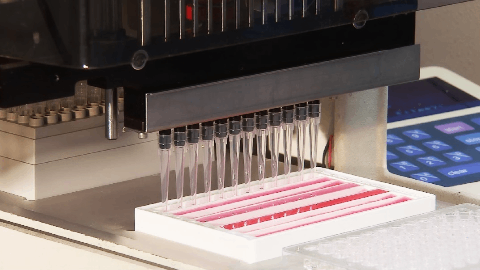预约演示
更新于:2025-05-07
Pancreatic Cancer
胰腺癌
更新于:2025-05-07
基本信息
别名 CA - Cancer of pancreas、CA - Pancreatic cancer、CARCINOMA OF PANCREAS + [137] |
简介 Tumors or cancer of the PANCREAS. Depending on the types of ISLET CELLS present in the tumors, various hormones can be secreted: GLUCAGON from PANCREATIC ALPHA CELLS; INSULIN from PANCREATIC BETA CELLS; and SOMATOSTATIN from the SOMATOSTATIN-SECRETING CELLS. Most are malignant except the insulin-producing tumors (INSULINOMA). |
关联
2,282
项与 胰腺癌 相关的药物作用机制 MEK1抑制剂 [+1] |
在研机构 |
最高研发阶段批准上市 |
首次获批国家/地区 美国 |
首次获批日期2025-02-11 |
作用机制 HER2拮抗剂 [+1] |
在研机构 |
原研机构 |
在研适应症 |
非在研适应症- |
最高研发阶段批准上市 |
首次获批国家/地区 美国 |
首次获批日期2024-12-04 |
作用机制 TOP1抑制剂 [+1] |
原研机构 |
在研适应症 |
非在研适应症- |
最高研发阶段批准上市 |
首次获批国家/地区 中国 |
首次获批日期2024-11-22 |
6,610
项与 胰腺癌 相关的临床试验NCT05041335
Wet Heparinized Suction: A Novel Technique to Enhance Tissue Acquisition for Endoscopic Ultrasound Guided Fine Needle Biopsy (EUS-FNB) of Solid Abdominal Masses: A Randomized Prospective Trial
The purpose of this research is to compare the amount and quality of tissue obtained by EUS-FNB when the device is flushed with an anticoagulant or "blood thinner" vs. saline a salt water solution as well as the use of a microsieve in order for the doctor to look at the tissue to check the acceptability of the specimens before sending for analysis.
You will be randomly assigned (like a flip of a coin) to have either the blood thinner or the salt water solution placed within the needle being used to sample your abdominal tumor and to have either a sieve used or not.
You will be one of 42 participants enrolled in this data collection study which includes 1 sites in the United States.
You will be randomly assigned (like a flip of a coin) to have either the blood thinner or the salt water solution placed within the needle being used to sample your abdominal tumor and to have either a sieve used or not.
You will be one of 42 participants enrolled in this data collection study which includes 1 sites in the United States.
开始日期2026-03-15 |
NCT06868693
Pancreatic Cancer of the Head: Effect of Neoadjuvant Chemotherapy in Elderly People - a Multicenter Observational Study
The goal of this observational retrospective cohort study is to evaluate the efficacy and safety of neoadjuvant chemotherapy (NAT) in elderly patients with resectable or borderline resectable (BR) pancreatic ductal adenocarcinoma (PDAC). The study includes patients aged ≥70 years who have undergone NAT followed by surgery or upfront surgery.
The main questions it aims to answer are:
Does NAT improve overall survival (OS) and progression-free survival (PFS) in elderly patients compared to upfront surgery? What is the impact of NAT on R0 resection rates, conversion rates in BR tumors, and the need for vascular resection? How does the toxicity profile of different NAT regimens affect treatment outcomes and patient tolerability? Researchers will compare NAT followed by surgery vs. upfront surgery to determine differences in oncologic outcomes and postoperative complications.
Participants will:
Be retrospectively identified from hospital records. Be classified based on treatment received (NAT vs. upfront surgery). Undergo data collection on tumor characteristics, treatment regimens, surgical details, and survival outcomes.
This study aims to refine patient selection criteria for NAT in elderly patients, guiding personalized treatment strategies to optimize survival and quality of life.
The main questions it aims to answer are:
Does NAT improve overall survival (OS) and progression-free survival (PFS) in elderly patients compared to upfront surgery? What is the impact of NAT on R0 resection rates, conversion rates in BR tumors, and the need for vascular resection? How does the toxicity profile of different NAT regimens affect treatment outcomes and patient tolerability? Researchers will compare NAT followed by surgery vs. upfront surgery to determine differences in oncologic outcomes and postoperative complications.
Participants will:
Be retrospectively identified from hospital records. Be classified based on treatment received (NAT vs. upfront surgery). Undergo data collection on tumor characteristics, treatment regimens, surgical details, and survival outcomes.
This study aims to refine patient selection criteria for NAT in elderly patients, guiding personalized treatment strategies to optimize survival and quality of life.
开始日期2026-01-01 |
NCT06759740
An Exploratory Study of 68Ga-DOTA-SEMA in Preoperative Precise Imaging of Patients with Glucagon-Like Peptide-1 Receptor (GLP1R) Positive Insulinomas
Traditional imaging techniques for insulinomas have a low detection rate. This study aims to evaluate the safety, internal radiation dosimetry, and targeted imaging capability of the novel GLP1R imaging agent, 68Ga-DOTA-SEMA, in patients with GLP1R-positive insulinomas.
开始日期2026-01-01 |
申办/合作机构 |
100 项与 胰腺癌 相关的临床结果
登录后查看更多信息
100 项与 胰腺癌 相关的转化医学
登录后查看更多信息
0 项与 胰腺癌 相关的专利(医药)
登录后查看更多信息
114,036
项与 胰腺癌 相关的文献(医药)2025-12-31·mAbs
Preclinical development of ozuriftamab vedotin (BA3021), a novel ROR2-specific conditionally active biologic antibody–drug conjugate
Article
作者: Short, Jay M. ; Frey, Gerhard ; Xing, Charles ; Boyle, William J. ; Chang, Hwai Wen ; Wang, Jing ; Liu, Haizhen ; Chen, Jian
2025-12-31·Annals of Medicine
Subnational trend and driving factors for pancreatic cancer burden in China, 1990–2021: an analysis based on the Global Burden of Disease Study 2021
Article
作者: Yin, Peng ; Zhou, Maigeng ; Qi, Jinlei ; Wang, Lijun ; Yu, Lingling ; Liu, Zhe ; Yan, Fanshu
2025-12-31·Drug Delivery
Synergistic effect of pH-sensitive PEGylated RG3-chitosan prodrug nanoparticles encapsulated celastrol on pancreatic cancer
Article
作者: Wu, Xiangxiang ; Zhang, Zheng ; Zhao, Lingzhou ; Su, Mengjiao ; Li, Xiaofang ; Wang, Jiaxing ; Zeng, Huahui ; Zhao, Junwei
9,524
项与 胰腺癌 相关的新闻(医药)2025-05-05
SAN DIEGO, CA, USA I May 05, 2025 I
Janux Therapeutics, Inc.
(Nasdaq: JANX) (Janux), a clinical-stage biopharmaceutical company developing a broad pipeline of novel immunotherapies by applying its proprietary technology to its Tumor Activated T Cell Engager (TRACTr) and Tumor Activated Immunomodulator (TRACIr) platforms, today announced the initiation of Phase 1b expansion studies in the ongoing
ENGAGER-PSMA-01
trial.
ENGAGER-PSMA-01 is a first-in-human, open-label, multicenter Phase 1 clinical trial designed to evaluate the safety, tolerability, pharmacokinetics, pharmacodynamics, and preliminary efficacy of JANX007 administered as monotherapy or in combination in adult patients with advanced metastatic castration-resistant prostate cancer (mCRPC).
In December 2024, Janux reported positive interim clinical data from the Phase 1a dose escalation portion of the trial in 16 mCRPC patients with a median of four prior lines of therapy. At that time, the median radiographic progression-free survival (rPFS) reported was 7.4 months for all 16 patients.* As of April 21, 2025, updated results** have been achieved in the same 16 patients supporting the initiation of the Phase 1b expansion studies:
*8/16 patients were noted as in-progress in the December 2024 reported results.
**rPFS results based upon Kaplan-Meier estimate.
In addition, Janux has selected a CRS-mitigation strategy to support the initiation of the Phase 1b expansion studies that is designed to maintain the CRS profile reported in December.
The first Phase 1b expansion study will enroll taxane-naïve mCRPC patients and is designed to generate additional safety and efficacy data in this first and second line (1L/2L) patient population. This study will assess JANX007 monotherapy at two dose regimens (0.3/2/6mg and 0.3/2/9mg) with dosing administered once weekly or once every two weeks in mCRPC patients who have progressed on or after novel hormonal therapy (NHT).
“Initiation of the taxane-naïve study marks an important step as we begin to evaluate JANX007 in earlier-line mCRPC patient populations,” said Zachariah McIver, D.O., Ph.D., Chief Medical Officer of Janux. “While therapeutic options for mCRPC have expanded, there remains a significant need for novel, non-chemotherapeutic approaches.”
Janux plans to initiate three additional Phase 1b expansion studies, evaluating:
“Improved efficacy and durability of responses has been observed by other prostate cancer drugs and TCEs when moving into earlier lines of therapy. There are also indications that safety with TCEs improve in earlier lines of therapy where disease burden is lower. We believe that these observations, coupled with the data seen in our Phase 1a dose escalation in later line patients, strongly support our decision to develop JANX007 in earlier lines of therapy,” said David Campbell, Ph.D., President and CEO of Janux.
Additional data from JANX007 and JANX008 will be presented at future Janux events in the second half of 2025. Separately, Janux will host an R&D Day in mid-2025 highlighting product candidates identified from its preclinical pipeline to move into clinical trials.
Janux’s TRACTr and TRACIr Pipeline
Janux’s first clinical candidate, JANX007, is a TRACTr that targets prostate-specific membrane antigen (PSMA) and is being investigated in a Phase 1 clinical trial in adult patients with metastatic castration-resistant prostate cancer. Janux’s second clinical candidate, JANX008, is a TRACTr that targets epidermal growth factor receptor (EGFR) and is being studied in a Phase 1 clinical trial for the treatment of multiple solid cancers including colorectal carcinoma, squamous cell carcinoma of the head and neck, non-small cell lung cancer, renal cell carcinoma, small cell lung cancer, pancreatic ductal adenocarcinoma and triple-negative breast cancer. We are also generating a number of additional TRACTr and TRACIr programs for potential future development, some of which are at development candidate stage or later. We are currently assessing priorities in our preclinical pipeline.
About Janux Therapeutics
Janux is a clinical-stage biopharmaceutical company developing tumor-activated immunotherapies for cancer. Janux’s proprietary technology enabled the development of two distinct bispecific platforms: TRACTr and TRACIr. The goal of both platforms is to provide cancer patients with safe and effective therapeutics that direct and guide their immune system to eradicate tumors while minimizing safety concerns. Janux is currently developing a broad pipeline of TRACTr and TRACIr therapeutics directed at several targets to treat solid tumors. Janux has two TRACTr therapeutic candidates in clinical trials, the first targeting PSMA is in development for prostate cancer, and the second targeting EGFR is being developed for colorectal carcinoma, squamous cell carcinoma of the head and neck, non-small cell lung cancer, renal cell carcinoma, small cell lung cancer, pancreatic ductal adenocarcinoma and triple-negative breast cancer. For more information, please visit
www.januxrx.com
and follow us on LinkedIn.
SOURCE:
Janux Therapeutics
临床1期免疫疗法临床结果
2025-05-05
- Oral presentation at ASCO to highlight topline Phase 2 data of elraglusib in combination with gemcitabine/nab-paclitaxel (GnP) in first-line treatment of metastatic pancreatic ductal adenocarcinoma (mPDAC)
April 23, 2025 -- Actuate Therapeutics, Inc. (NASDAQ: ACTU) (“Actuate” or the “Company”), a clinical-stage biopharmaceutical company, focused on developing therapies for the treatment of high-impact, difficult-to-treat cancers through the inhibition of glycogen synthase kinase-3 beta (GSK-3β), today announced that topline clinical data from the randomized Phase 2 study (Actuate-1801 Part 3B) evaluating elraglusib have been selected for oral presentation at the 2025 American Society of Clinical Oncology (ASCO) Annual Meeting, to take place May 30- June 3, in Chicago, Illinois.
Abstract Title: Preliminary results from the randomized phase 2 study (1801 part 3B) of elraglusib in combination with gemcitabine/nab-paclitaxel (GnP) versus GnP alone in patients (pts) with previously untreated metastatic pancreatic ductal adenocarcinoma (mPDAC).
Abstract Number: 4006
Session Title: Gastrointestinal Cancer—Gastroesophageal, Pancreatic, and Hepatobiliary
Session Date and Time: Saturday, May 31, 2025, 3:00 PM-6:00 PM CDT
Actuate is a clinical-stage biopharmaceutical company focused on developing therapies for the treatment of high-impact, difficult-to-treat cancers. Actuate’s lead investigational drug, elraglusib (a novel GSK-3β inhibitor), targets molecular pathways in cancer that are involved in promoting tumor growth and resistance to conventional cancer drugs such as chemotherapy through the inhibition of nuclear factor kappa-light-chain-enhancer of activated B cells (NF-kB) and DNA Damage Response (DDR). Elraglusib may also mediate anti-tumor immunity through the regulation of multiple immune checkpoints and immune cell function.
The content above comes from the network. if any infringement, please contact us to modify.

ASCO会议临床结果
2025-05-05
·深蓝观
李昀 | 撰文又一 | 编辑上周(4月30日),为期六天的AACR(美国癌症研究协会)年会在芝加哥闭幕。作为领域内最重要的展示平台和交流机会,来自中国的参会者给出了足够高的关注。“每年AACR来自中国的参会者都越来越多,但今年和去年相比,感觉是爆发式的增长。亚洲面孔充斥了各种场合,尤其是一些我们擅长的领域,比如ADC。”一名参会多年的行业人士说到。根据统计,这次来参会的中国药企有111家,设计创新药246款;其中ADC就有86款,占比35%。其中不少公司,已经在今年的JPM上有过亮相。但AACR和JPM、ASCO的侧重点略有不同,因此参会目的也不同。“在JPM上,投资者是主角。公司的团队也是希望能拿到合作和资金。而AACR和ASCO则更偏向科研:其中AACR上来自公司的研发人员比较多,而ASCO来的临床医生会比较多。”“所以和JPM相比,AACR的会间谈话都是有点nerd的。”上述人士调侃道,“氛围上有细微的差别。在JPM上大家身上多少带着些任务,但是来AACR就感觉就是纯粹来上学的,聊天的都是同学。”随着今年国内资本环境没有明显转好,而出海的口子却越扩越大,因此,在学术展示和交流之外,参会企业也会尤其留心两类信息:一是MNC都在干什么;二是公司核心管线的竞品数据。“有些公司会选择在JPM上接触MNC。但在JPM上,MNC展示的一般都是比较成熟的管线;而在AACR上,你能看到这些MNC又有什么新方向。可能数据的不确定性还很高,但这正是可以合作的地方。”一名在美工作的BD说到。-01-来自MNC的消息由于AACR是很多新药和新疗法首次亮相的舞台,因此展出内容以早中期临床分析为主。其中不少展现出令人惊艳的潜力,但由于距离成功还有一段距离,因此外界关注度一般。但不可否认的是,它们提示了未来行业的可能性。比如来自勃林格殷格翰的HER2突变NSCLC新药 Zongertinib,在这次大会上就受到了很大关注。这是一种TKI类药物,最新公布的三期临床数据极其乐观:ORR高达71%,为该亚型癌症中前所未有的高水平。要知道,上一个同适应症新药Enhertu在去年的全球销售额达到了37.54亿美元。这说明虽然针对HER2这一靶点的研究已经不算新鲜,但其可能带来的商业价值还远远未饱和。而Enhertu的ORR为50%左右,仅这一点而言Zongertinib就表现出很大的潜能。同时,Zongertinib 的给药方式为口服,和注射的Enhertu相比依从性更好。“单就这一个适应症而言,Zongertinib未来成为标准疗法的可能性很大。但是技术手段不同,TKI对突变位点的要求更高,所以不太适合跨癌种。”另一款引发重点讨论的新药是来自GSK的Jemperli。年会上,GSK主要展示了这款PD-1单抗的最新治疗数据:在治疗103名dMMR/MSI-H局部晚期直肠癌患者时,84名出现临床完全缓解,即没有癌症迹象,而其中82名患者未接受手术。这项研究之所以重要,是因为它给予了一种可能性:未来的癌症治疗,患者不需要手术、化疗或放疗,可以实现器官保留。纽约纪念斯隆凯特琳癌症中心的研究负责人也对这项研究高度评价:如果在更大规模的试验中证实这一结果,单独使用免疫疗法是完全可能实现的。因此,尽管dMMR/MSI-H局部晚期直肠癌属于小适应症,但它提示了免疫治疗在“完全治愈”和“替代入侵式治疗”上存在很大发展空间,或许会颠覆目前局部癌症的治疗模式。K药也带来了一些新鲜的适应症。比如Keynote-689这项针对局部晚期头颈部鳞状细胞癌的临床,将患者的复发或死亡风险降低了27%。虽然和其它适应症相比,K药这次数据表现比较一般,但这是该癌种“在二十多年来的首个阳性实验”,因此对患者而言具有里程碑的意义。该适应症的上市申请正在接受FDA 优先审查,将于6月得到答复。可以看到,在这次的AACR上,曝光度比较高的还是一些老药和老靶点。也因此,不少参会者认为今年是“小年”。“今年大药企很多都是公布随访数据,没有什么FIC的新动作。之后在ASCO上会有更加详细的数据释出,目的还是为临床推广做准备。”上述参会人员说到。-02-KRAS受到关注在今年AACR上,对于KRAS这一靶点来说足以称得上是大年了。在过去几年的重要行业年会上,KRAS的风头一直被TROP2、CLDN18.2等热门靶点盖过,直到今年多个KRAS G12D抑制剂首次公布临床前或临床I期数据,并表现出优异效果,引起了各方兴趣。“KRAS G12C曾经火过一阵子,但效果相对其它治疗方式,确实没有太突出的地方。现在轮到G12D了,相对于G12C来说,它适合的胰腺癌没有太多靶向药物,所以突破的意义更大。”上述参会人员解释道。劲方医药和Verastem联合开发的VS-7375公布了一项临床前数据,显示其在治疗KRAS G12D突变的胰腺癌患者上有一定发现。研究显示,VS-7375能同时作用于KRAS 蛋白的 “开启”和“关闭”状态,这意味着无论该蛋白是否促进细胞增殖,它都能发挥作用。目前,劲方已在国内开展该药的II期临床试验,而Verastem则预计于年中开启I/IIa期试验。来自Revolution的Zoldonrasib拿出了Ⅰ期结果:在 90 例KRAS G12D突变的晚期实体瘤患者中,对其中18 例可评估疗效的非小细胞肺癌患者进行分析,ORR为 61%,DCR为89%,中位缓解时间为1.4 个月,这表明药物起效相对较快,且与传统标准治疗多西他赛相比有显著提高。除了KRAS G12D以外,已有药品上市的KRAS G12C药物也在曾经困扰过的问题上有了一些突破。来自安进的Sotorasib和来自Mirati的Adagrasib都属于已经上市的KRAS G12C药物,用以治疗相关突变NSCLC,在耐药性上被市场验证为较差。而在此次AACR大会上,一些新思路提供了解决方向:比如Genprex公司的研究展示了通过基因疗法克服Sotorasib获得性耐药问题等。同时,之前KRAS G12C主要用于NSCLC的治疗,而此次AACR上的报告显示:其与EGFR 抗体Sotorasib + 帕尼单抗,Adagrasib + 西妥昔单抗)的联合治疗对结直肠癌也很有效果。两家公司都在今年对临床的最新进展做了汇报。除了上述提到的几款药物,还有礼来的LY4066434、阿斯利康的AZD0240带来了相关内容的展示。由于阶段尚早,展示内容主要集中在抗肿瘤活性上。但这两家公司切入KRAS的方式比较特别:礼来做的是泛KRAS抑制剂,旨在应对多种突变;阿斯利康做的则是TCR-T疗法。那么,这一次的KRAS热是否会是昙花一现?上述BD人士认为,这股热潮能否持续下去,还要看后续的证据支持。“接下来的ASCO上,大概率会有更多相关的数据展出。但这个领域的探索比较少,临床风险比较高,所以不太可能出现一窝蜂内卷的情况。”-03-ADC的天下和之前几届一样,这一届AACR的ADC展示,依然被中国药企承包了。而一些ADC新靶点的展示,也为这次有些沉寂的大会带来了一些变化。其中讨论度最高的就是CDH17。这一靶点虽然具有很多理想特性:比如组织特异性,但它在部分正常组织中仍有可检测水平。以前,当ADC的连接子还不够稳定时,这种研发风险较高的靶点常常被视为边缘。而如今随着ADC技术的提升,对这一新靶点的尝试也越来越多。今年的AACR上,做出相关报告的中国企业就不胜枚举:包括维立志博的LBL-054、华东医药的HDM2017、宜联生物的YL127、SOTIO Biotech的SOT109、博奥信生物的BSI-721、橙帆医药的VBC108、礼新医药的LM-350、先声药业的SCR-A008等。同样第一个开始吃螃蟹的还有基石药业的CS5006,这是同类首创、靶向全新靶点ITGB4 的ADC,目标适应症包括NSCLC、头颈鳞状细胞癌、食管鳞状细胞癌等。AACR上展示的临床前研究显示,CS5006在多种动物模型中均表现出强效的抑瘤作用,且耐受性良好。除了新靶点以外,不少公司在技术手段上也多有探索。比如康弘药业的KH815,就是全球首款进入临床阶段的双毒素 ADC 新药。它搭载了拓扑异构酶1 抑制剂和 RNA 聚合酶 II 抑制剂两种有效载荷,可以通过协同作用进行多维打击,从而克服传统单毒素 ADC 存在的耐药现象。再比如宜联生物开发的非内吞ADC,通过肿瘤微环境特异性酶来释放毒素,进一步打开了 ADC 药物的应用空间。尽管上述创新度较高的管线目前还处于临床前或临床早期,但它们的大部分都被高盛选为今年大会上最值得关注的中国资产。由此可以看出不仅是MNC,国外资本同样意识到了国内早期开发工作的价值所在。“这次ADC展出给我的总体感觉是,国内企业的胆子确实越来越大了。”上述BD人士由于长期不在国内,同时也不是ADC领域从业者,因此对这次的全新印象感到有些惊讶。“这说明很大情况下,‘内卷’是信心不足的结果。在积累了那么多出海的成功案例之后,感觉国内越来越放开手脚了。”就在一个月后,同样在芝加哥,另一场行业盛会ASCO也将举行。尽管大环境的向好变化很难体察,但可以肯定的是:这些公司不会停下他们前往的脚步。......欢迎添加作者交流:李昀:liyun940820
AACR会议临床结果抗体药物偶联物ASCO会议
分析
对领域进行一次全面的分析。
登录
或

生物医药百科问答
全新生物医药AI Agent 覆盖科研全链路,让突破性发现快人一步
立即开始免费试用!
智慧芽新药情报库是智慧芽专为生命科学人士构建的基于AI的创新药情报平台,助您全方位提升您的研发与决策效率。
立即开始数据试用!
智慧芽新药库数据也通过智慧芽数据服务平台,以API或者数据包形式对外开放,助您更加充分利用智慧芽新药情报信息。
生物序列数据库
生物药研发创新
免费使用
化学结构数据库
小分子化药研发创新
免费使用





